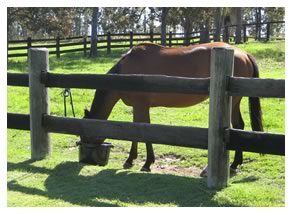
Home › Symptoms which may indicate a Spinal Problem
In general, signs of pain from a spinal problem include:
- Facial expression of apprehension of pain - a frowning, worried look.
- Wringing the tail and lying the ears down flat. Swishing of the tail.
- Sensitivity of parts of the neck or body or back to touch, or being brushed.
- Refusal or unwillingness to perform, including refusal at jumps.
Signs of upper neck, poll and jaw (tempero-mandibular joint) problems include:
- Head tossing or nodding under saddle or even in the paddock.
- Unpredictable behaviour.
- Being touchy around the ears. May not be able to touch the poll in bad cases.
- Running out on corners in races or alternatively running in towards the rail.
- Frequent yawning or jaw opening.
Signs of wither and mid back problems include:
- Tenderness to touch and brushing,
- Exaggerated and frequent flicking of the skin over the wither.
- Dipping the back when pressed over the saddle contact areas.
- Signs of saddle soreness (see later).
- Loss of muscle over the saddle area.
- Going down in the back when being mounted.
Signs of girth pain resulting from jammed up withers/thoracic vertebrae include:
- While being girthed – worried look and putting the head up or most commonly attempting to bite the handler whilst being girthed, or in more extreme cases, frantic, uncontrollable bucking or pigrooting after being girthed. Sometimes, instead of bucking etc, the horses collapse to the ground on fastening the girth.
- Exacerbation of other problems, such as head tossing and nervousness.
- Resistance to leg aids.
- Grunting while being girthed or being ridden, especially when going down hill.
- Initial refusal or resistance to moving forward.
- Inflating or “blowing up” the chest while being girthed.
- Sensitivity of the skin and muscles behind the elbow and including the pectoral muscles. Often there is also increased sensitivity of the skin and muscles at the highest part of the wither .
- Shortened foreleg stride, especially on tight corners and going downhill.
- Decreased ability to stretch out at the end of a race. Often tend to “jar up”.
- Foot problems: as a result of restricted muscle action at the top of the shoulder blade and in some cases, of the triceps.
Signs of lower back and pelvic or sacro-iliac problems include:
- Favouring one hind leg when standing, and continually shifting from one leg to another.
- Gait short and/or stiff in one or both hindlegs.
- Locking or clicking patellas (kneecaps) This is the most common source of clicking coming from the back legs.
- Hindleg lameness.
- Tightness of one side of the rump and skin tenderness over the rump or above the tail.
- Lugging or hanging.
- Tying up or fading in races.
Back and neck problems may also cause changes in muscle coordination and flexibility that affects the ability of the horse to perform.
Things that are seen of this nature include:
- Lack of coordination of gait.
- Stiffness when coming out of the stall.
- Stiffness in sideways movements of the neck or back.
- Muscle wastage over the back, rump or neck.
- Rope walking or plaiting.
- Shortened stride in one or two limbs.
- Inability to engage the rear quarters.
- Inability to lengthen the top line.
- Being above the bit or not coming onto the bit.
- Lameness.
- On one line or pulling on one rein.
- Gaiting so that the rider cannot sit centred on the horse.
- Not using the back ie leg movers.
Nerves to the skin are often affected with back problems. This can cause hot or cold spots, local itchiness, with unusual body or tail rubbing, and patchy sweating.
